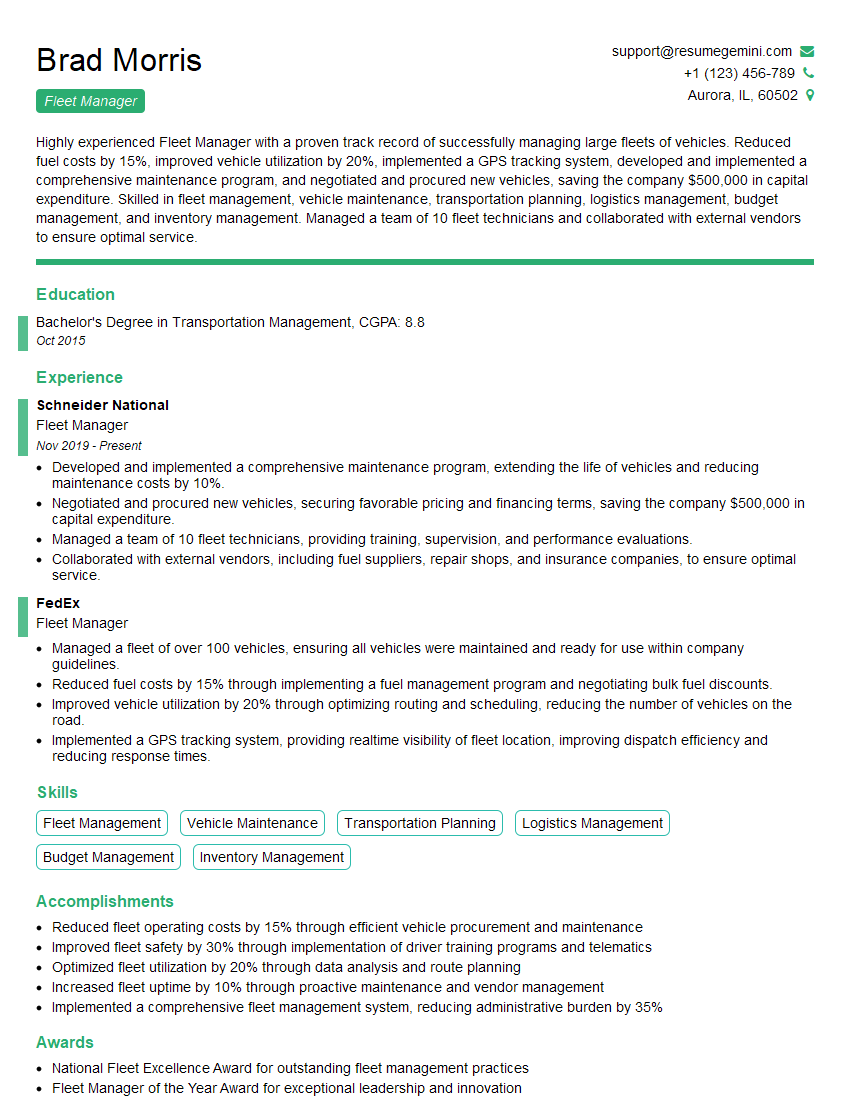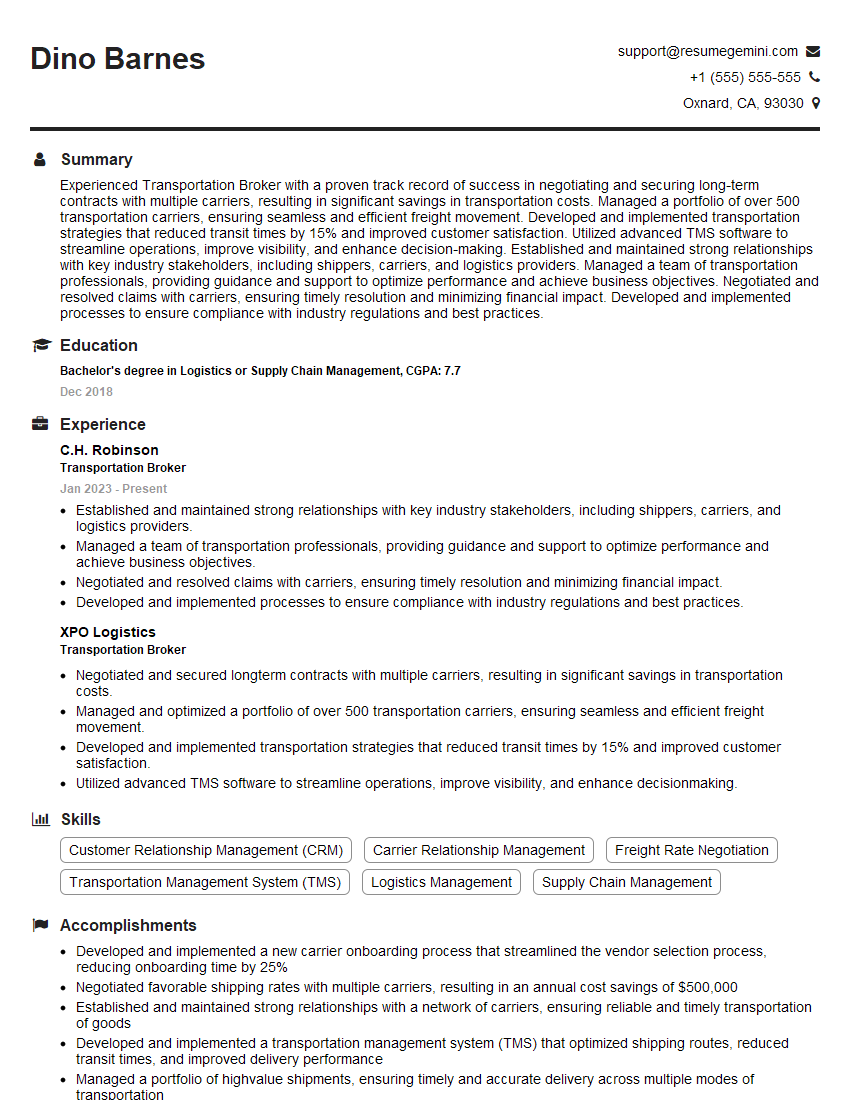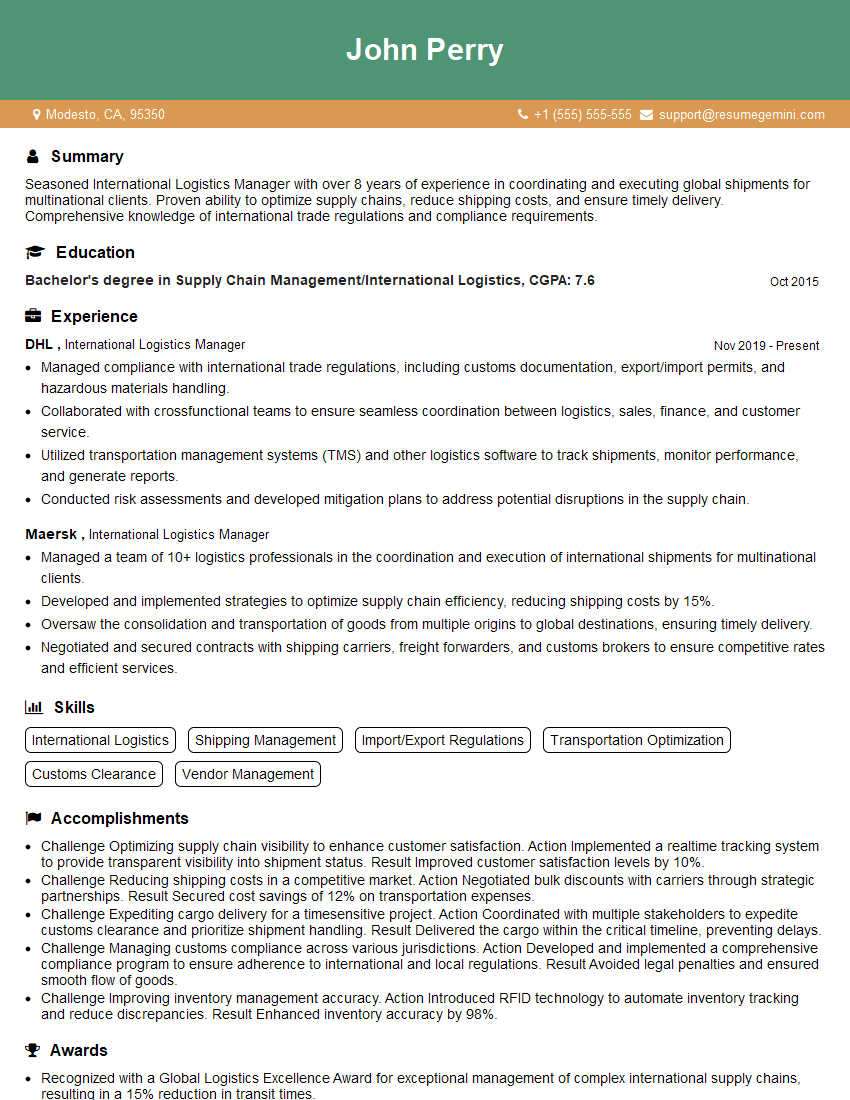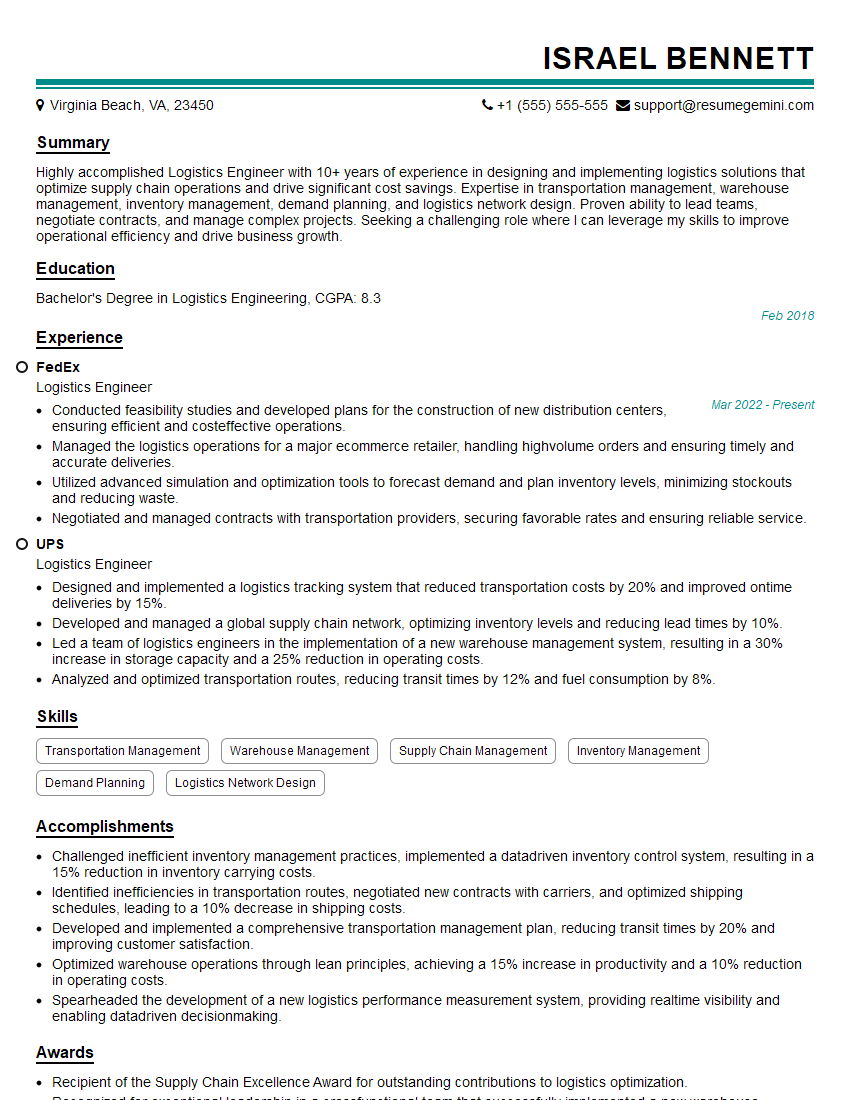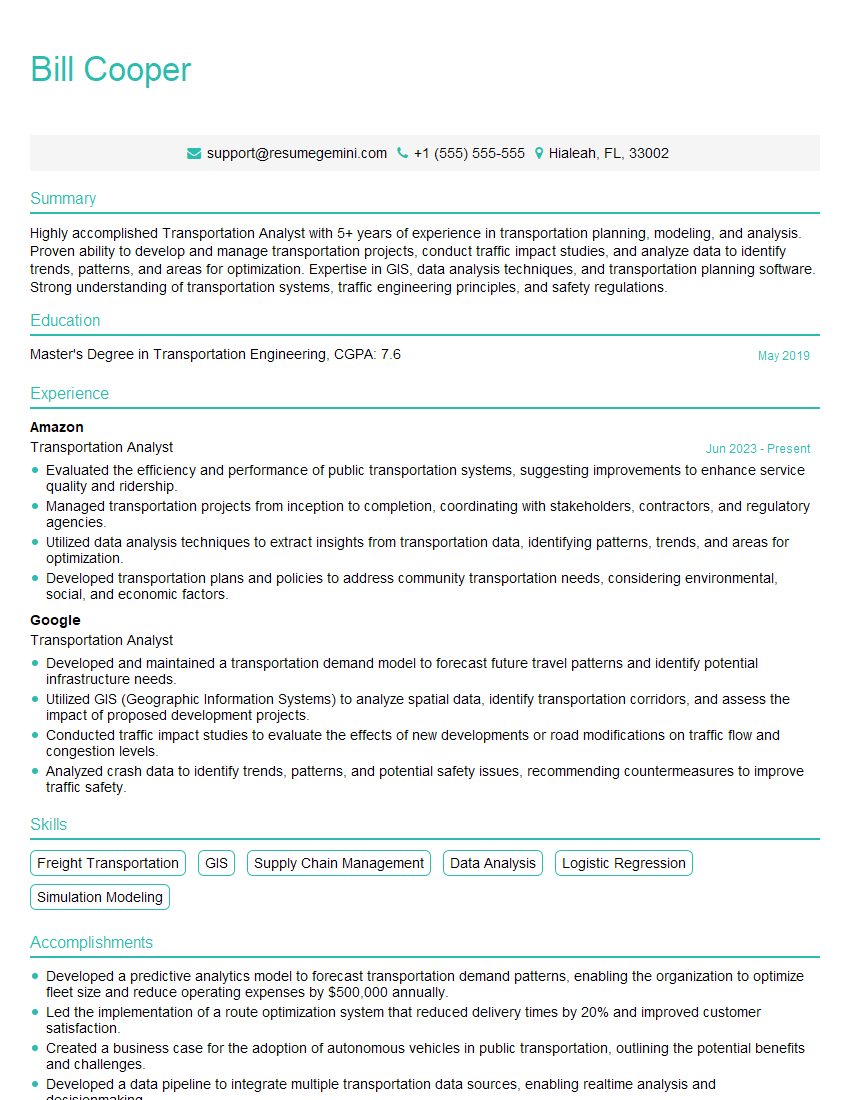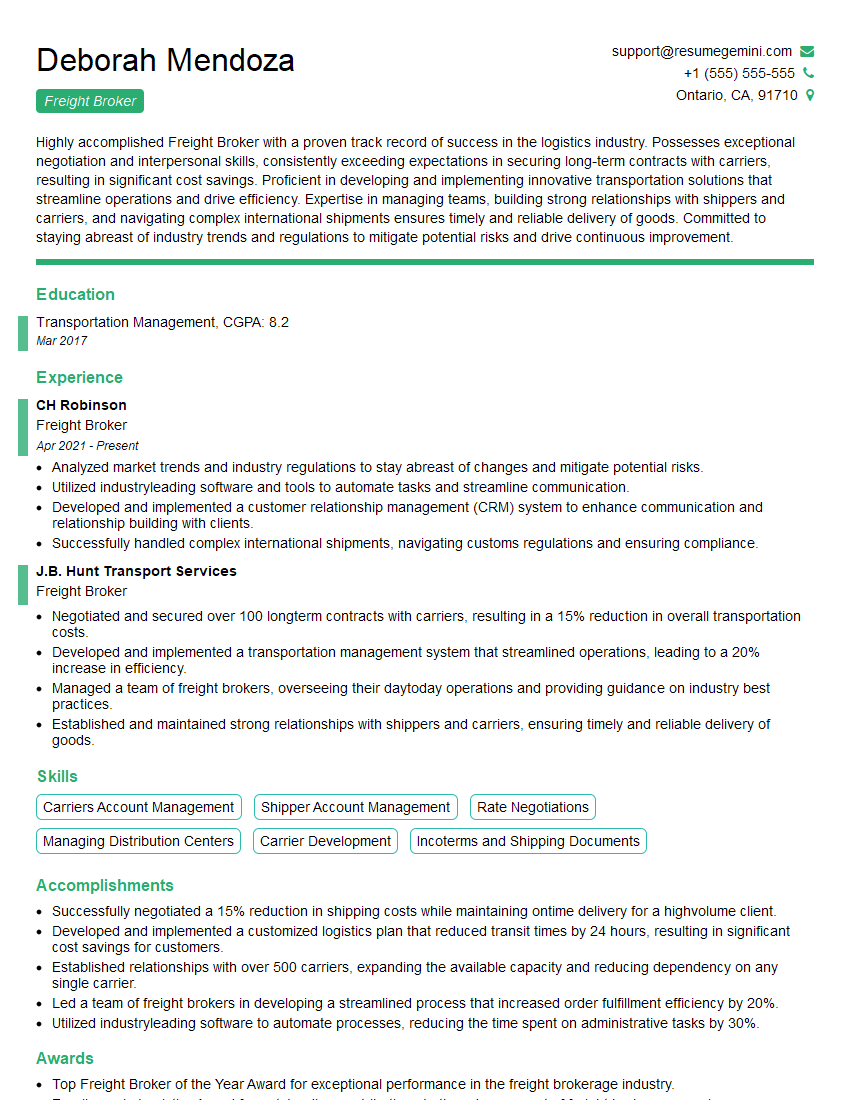Preparation is the key to success in any interview. In this post, we’ll explore crucial Log Transportation and Logistics interview questions and equip you with strategies to craft impactful answers. Whether you’re a beginner or a pro, these tips will elevate your preparation.
Questions Asked in Log Transportation and Logistics Interview
Q 1. Explain the difference between LTL and FTL shipping.
LTL (Less-than-Truckload) and FTL (Full Truckload) shipping are two distinct methods for transporting goods by truck. The key difference lies in the amount of cargo space utilized. FTL involves using an entire truck dedicated to a single shipper’s cargo, while LTL involves consolidating smaller shipments from multiple shippers into a single truck.
Think of it like this: FTL is like hiring a private taxi, you have the whole vehicle to yourself. LTL is like taking a shared bus – you share the space with others, resulting in a lower cost per unit but potentially longer transit times due to multiple stops for pick-up and delivery.
- FTL: Ideal for large shipments requiring speed and security, often more expensive but faster.
- LTL: Cost-effective for smaller shipments, sharing transport costs with others, but slower due to multiple stops and handling.
Choosing between LTL and FTL depends on factors such as shipment size, urgency, budget, and the distance of the transport.
Q 2. Describe your experience with different transportation modes (e.g., truck, rail, air, sea).
My experience spans all major transportation modes. I’ve extensively managed logistics using trucking for regional deliveries, leveraging rail freight for cost-effective long-distance movement of bulk materials, and utilizing air freight for time-sensitive shipments of high-value goods. I also have experience with ocean freight, particularly for international trade, handling everything from container consolidation to customs clearance.
For example, in a recent project, we optimized a client’s supply chain by shifting from primarily trucking to a combination of rail and trucking for their product distribution across the country. This led to a 15% reduction in transportation costs without significantly impacting delivery times. Each mode offers distinct advantages and limitations, and selecting the optimal mode requires careful consideration of factors like distance, weight, volume, transit time, and cost. I am proficient in understanding and mitigating the risks associated with each mode, such as weather delays in air freight or port congestion in ocean freight.
Q 3. How do you optimize transportation routes for efficiency and cost-effectiveness?
Optimizing transportation routes requires a multi-faceted approach. I employ route optimization software, integrating real-time traffic data, geographical information systems (GIS), and historical shipment data. This allows me to identify the shortest and most efficient routes, minimizing fuel consumption and transit times.
Beyond software, I also consider factors like:
- Delivery windows: Scheduling deliveries to avoid peak traffic hours.
- Weight and volume limitations: Ensuring routes are compatible with vehicle capacity.
- Road conditions and restrictions: Avoiding congested areas or roads under construction.
- Driver availability and fatigue management: Adhering to regulations to prevent driver burnout.
For instance, in one project, by implementing a sophisticated route optimization system, we reduced the average delivery time by 12% and decreased fuel consumption by 8%, resulting in significant cost savings for the client.
Q 4. What are the key performance indicators (KPIs) you monitor in log transportation?
Several key performance indicators (KPIs) are crucial for monitoring log transportation efficiency and effectiveness. These include:
- On-time delivery rate: Measures the percentage of shipments delivered within the scheduled timeframe.
- Freight cost per unit: Tracks the cost-effectiveness of transportation.
- Average delivery time: Monitors the overall speed of the transportation process.
- Fuel efficiency: Assesses the environmental impact and cost of fuel consumption.
- Damage rate: Tracks the frequency of cargo damage during transit.
- Driver retention rate: Indicates the effectiveness of driver management strategies.
Regularly monitoring these KPIs allows for proactive identification of bottlenecks and areas for improvement. Analyzing trends in these metrics helps identify systemic issues that require attention.
Q 5. Explain your experience with TMS (Transportation Management System) software.
I have extensive experience with various TMS (Transportation Management System) software, including both cloud-based and on-premise solutions. My proficiency includes system configuration, data integration, route optimization module utilization, and reporting and analytics. I’m comfortable using TMS to manage freight tenders, track shipments in real-time, and generate insightful reports on key performance indicators.
For example, I recently implemented a new TMS system for a large logistics company, which resulted in a 10% improvement in operational efficiency and a 5% reduction in transportation costs within the first six months. My expertise goes beyond simple software usage; I understand how to leverage the system’s features to create automated workflows, reducing manual intervention and minimizing errors.
Q 6. How do you handle unexpected delays or disruptions in the transportation process?
Handling unexpected delays or disruptions requires a proactive and flexible approach. My strategy involves:
- Real-time monitoring: Using tracking systems to identify delays promptly.
- Communication: Maintaining open communication with clients, drivers, and other stakeholders.
- Contingency planning: Having alternative routes and transportation modes available.
- Problem-solving: Identifying root causes and implementing corrective actions.
- Documentation: Maintaining detailed records of incidents and resolutions.
For instance, during a recent severe winter storm, I swiftly rerouted shipments, utilizing alternative transportation modes, minimizing delivery delays and preventing significant losses for our clients. This involved close collaboration with our trucking partners and effective communication to manage client expectations.
Q 7. Describe your experience with inventory management and warehousing.
My experience with inventory management and warehousing is integral to my logistics expertise. I’m familiar with various inventory management techniques, including FIFO (First-In, First-Out) and LIFO (Last-In, First-Out), and understand the importance of accurate inventory tracking to optimize warehouse space and minimize storage costs.
I’ve worked with different Warehouse Management Systems (WMS) to manage inventory levels, track product movement, and optimize warehouse operations. Effective inventory management minimizes storage costs, prevents stockouts, and ensures timely order fulfillment. In a previous role, I implemented a new WMS which reduced our inventory holding costs by 7% and improved order fulfillment times by 10%. This involved optimizing warehouse layout, improving picking and packing processes, and implementing robust inventory control measures.
Q 8. How do you ensure compliance with transportation regulations and safety standards?
Ensuring compliance with transportation regulations and safety standards is paramount in log transportation and logistics. It’s not just about avoiding penalties; it’s about ensuring the safety of personnel, cargo, and the environment. My approach is multi-faceted:
- Proactive Compliance: I meticulously stay updated on all relevant federal, state, and local regulations, including those related to hazardous materials (HAZMAT), weight limits, driver hours of service (HOS), and environmental protection. I utilize subscription services to regulatory updates and actively participate in industry webinars and conferences.
- Driver Training and Monitoring: Our drivers receive comprehensive training on safety protocols, defensive driving techniques, and compliance regulations. We employ electronic logging devices (ELDs) to monitor hours of service and ensure adherence to regulations. Regular vehicle inspections are mandatory, and any safety issues are addressed immediately.
- Documentation and Record Keeping: Meticulous record-keeping is vital. We maintain detailed logs of shipments, driver information, vehicle maintenance, and safety inspections. This allows for easy audits and demonstrates our commitment to compliance. This includes proper documentation for HAZMAT shipments, following strict guidelines for manifest preparation and handling.
- Third-Party Audits: We regularly engage third-party auditors to conduct independent assessments of our compliance program. This provides an objective evaluation and helps identify areas for improvement.
- Incident Reporting and Investigation: Any accidents or incidents are thoroughly investigated to determine the root cause and implement corrective actions. This includes submitting reports to the relevant authorities as required.
For example, during a recent shipment of hazardous materials, a minor discrepancy was found in the documentation. Our proactive compliance measures allowed us to quickly identify and rectify the issue before it escalated into a major problem, preventing potential fines and safety risks.
Q 9. What is your experience with international shipping and customs regulations?
My experience with international shipping and customs regulations is extensive. I’ve managed countless shipments across various continents, navigating the complexities of different regulatory environments. This involves a deep understanding of:
- Harmonized System (HS) Codes: Accurate classification of goods using HS codes is crucial for determining tariffs and duties. I have experience in researching and applying the correct codes to ensure smooth customs clearance.
- Export Controls and Sanctions: I’m well-versed in export regulations and sanctions imposed by different countries. We conduct thorough due diligence to ensure compliance and avoid potential legal issues.
- Customs Documentation: Preparing and submitting all necessary customs documentation, including commercial invoices, packing lists, certificates of origin, and other required forms, is critical. I understand the nuances of documentation requirements for various countries.
- Freight Forwarders and Customs Brokers: I have established strong relationships with reputable freight forwarders and customs brokers who provide expertise and support in navigating international regulations. Their local knowledge and experience are invaluable.
- Incoterms (explained in more detail in the next answer): Understanding Incoterms is fundamental to managing international shipments. It clearly defines the responsibilities of the buyer and seller, minimizing disputes and ensuring a smoother process.
For instance, in a recent shipment to Japan, we encountered a delay due to an incorrectly classified HS code. My experience allowed me to quickly resolve the issue by working with our customs broker to correct the code and expedite customs clearance. The result was minimizing delays and extra costs for our client.
Q 10. Explain your understanding of Incoterms.
Incoterms, or International Commercial Terms, are a standardized set of three-letter trade terms published by the International Chamber of Commerce (ICC). They define the responsibilities of the buyer and seller in an international transaction, specifying who is responsible for costs, risks, and the transfer of goods at various stages of the shipping process. Understanding Incoterms is essential for avoiding misunderstandings and disputes.
Some key Incoterms include:
- EXW (Ex Works): The seller makes the goods available at their premises. The buyer bears all risks and costs from that point onwards.
- FOB (Free on Board): The seller delivers the goods to the named port of shipment, cleared for export. The buyer bears the costs and risks of carriage from that point.
- CIF (Cost, Insurance, and Freight): The seller delivers the goods to the named port of destination, including costs, insurance, and freight. The buyer bears the risks of loss or damage upon arrival at the destination.
- DAP (Delivered at Place): The seller delivers the goods to the named place of destination, cleared for import, ready for unloading. The buyer bears the costs of unloading.
- DPU (Delivered at Place Unloaded): Similar to DAP, but the seller is also responsible for unloading the goods.
Choosing the appropriate Incoterm is crucial for mitigating risks and ensuring a smooth transaction. The selection depends on factors like the type of goods, transportation mode, and the relationship between buyer and seller. For example, choosing FOB for a high-value shipment might be risky for the buyer if not properly insured.
Q 11. How do you manage relationships with carriers and suppliers?
Managing relationships with carriers and suppliers is critical for efficient and cost-effective log transportation. My approach focuses on building strong, mutually beneficial partnerships:
- Strategic Selection: We carefully select carriers and suppliers based on factors like reliability, safety record, capacity, and pricing. We consider their experience with specific routes and cargo types.
- Performance Monitoring: We monitor carrier and supplier performance closely, tracking on-time delivery rates, damage claims, and compliance with our service level agreements (SLAs). Regular performance reviews are conducted.
- Open Communication: We maintain open and transparent communication with carriers and suppliers. This includes regular meetings, feedback sessions, and proactive communication regarding any potential issues.
- Collaboration and Problem Solving: When challenges arise, we collaborate with carriers and suppliers to find effective solutions. This proactive approach helps maintain positive relationships and mitigate disruptions.
- Fair and Timely Payments: We ensure fair and timely payments to carriers and suppliers to maintain good standing and encourage continued collaboration.
For example, during a period of high demand, we worked closely with our key carriers to secure additional capacity and avoid delays. This involved negotiating favorable rates and ensuring clear communication about our needs. Our strong relationships were instrumental in navigating this challenging situation.
Q 12. How do you handle customer inquiries and complaints related to transportation?
Handling customer inquiries and complaints related to transportation is crucial for maintaining customer satisfaction and loyalty. My approach is to be responsive, empathetic, and proactive:
- Prompt Response: We respond to all inquiries and complaints promptly, acknowledging receipt and providing updates on the progress of our investigation.
- Thorough Investigation: We conduct thorough investigations into all complaints, gathering relevant information from involved parties, including carriers, drivers, and warehouse personnel. This often involves reviewing shipment tracking data, delivery documentation, and communication logs.
- Transparent Communication: We keep customers informed throughout the investigation and resolution process, providing clear and concise updates. We explain the steps we are taking and provide realistic timelines.
- Fair and Equitable Resolution: We aim to reach a fair and equitable resolution for all parties involved. This may involve issuing refunds, credits, or other forms of compensation, depending on the specific circumstances.
- Continuous Improvement: We use customer feedback to identify areas for improvement in our transportation processes. This helps prevent similar issues from occurring in the future. We document all complaints and resolutions to track trends and identify systemic issues.
For example, a customer recently complained about a damaged shipment. Our investigation revealed a problem with the packaging. We reimbursed the customer for the damaged goods, implemented new packaging standards, and educated the warehouse staff about proper packing procedures to prevent this from recurring.
Q 13. Describe your experience with freight auditing and cost analysis.
Freight auditing and cost analysis are essential for optimizing transportation costs and identifying areas for improvement. My experience encompasses various aspects:
- Data Collection and Analysis: We collect data from various sources, including carrier invoices, freight bills, and tracking information. This data is then analyzed to identify discrepancies, overcharges, and areas of inefficiency.
- Rate Negotiation and Contract Management: We negotiate favorable rates with carriers and suppliers, ensuring that contracts are structured to meet our needs and protect our interests. We analyze market rates to ensure competitiveness.
- Cost Modeling and Forecasting: We develop cost models to predict future transportation expenses, enabling better budget planning and resource allocation. We take into account seasonal fluctuations and other relevant factors.
- Identifying Cost Savings Opportunities: Through data analysis and process improvement initiatives, we identify opportunities to reduce transportation costs. This might involve optimizing routes, consolidating shipments, or negotiating better rates with carriers.
- Reporting and Dashboards: We create regular reports and dashboards to monitor transportation costs and performance, providing key insights to management.
For example, a recent audit revealed that we were being overcharged on certain fuel surcharges by a particular carrier. By negotiating a revised agreement, we achieved significant cost savings without compromising service quality.
Q 14. How do you utilize data analytics to improve transportation efficiency?
Data analytics plays a crucial role in improving transportation efficiency and reducing costs. We leverage data to:
- Route Optimization: Using GPS data and advanced algorithms, we optimize delivery routes to minimize mileage and transit times. This is often done using Transportation Management Systems (TMS) that offer route optimization features.
- Predictive Modeling: We use historical data and machine learning techniques to predict future demand, allowing for more effective capacity planning and resource allocation. This helps avoid bottlenecks and delays.
- Carrier Performance Analysis: We use data to analyze carrier performance, identifying areas for improvement and selecting the most reliable and efficient carriers.
- Identifying Bottlenecks and Inefficiencies: Data analysis helps pinpoint bottlenecks in our transportation processes, such as delays at loading docks or inefficient warehouse operations. This allows us to implement targeted improvements.
- Real-time Tracking and Visibility: Real-time tracking systems provide complete visibility into shipment location and status, enabling proactive issue resolution and improving customer service.
For example, through data analysis, we discovered a pattern of delays at a particular distribution center. By investigating the root cause, we identified a process inefficiency in the loading process. Implementing changes to improve loading procedures resulted in a significant reduction in transit times and improved on-time delivery performance.
Q 15. What are your strategies for risk management in log transportation?
Risk management in log transportation is paramount. It’s about proactively identifying, assessing, and mitigating potential threats to the timely and safe delivery of goods. My strategy is multifaceted and involves:
Comprehensive Risk Assessment: This includes analyzing potential hazards across the entire supply chain – from harvesting to final delivery. This might involve assessing weather patterns impacting road conditions, evaluating the security risks at various storage points, or considering the potential for equipment malfunctions.
Mitigation Planning: Once risks are identified, I develop specific mitigation strategies. This could involve route optimization to avoid high-risk areas, investing in advanced tracking technology to monitor shipments in real-time, or implementing stringent security protocols at loading docks.
Insurance and Contingency Planning: Adequate insurance coverage is crucial to protect against unforeseen events like accidents or theft. This also involves having backup plans in place for potential delays or disruptions—such as alternative transportation routes or temporary storage solutions.
Regular Monitoring and Review: Risk management isn’t a one-time event. I regularly monitor key performance indicators (KPIs) related to safety and security, reviewing our processes and strategies to ensure they remain effective and adapt to changing circumstances. For example, we might analyze accident rates to identify trends and adjust driver training accordingly.
For instance, during a recent project involving transporting timber across mountainous terrain, we implemented a detailed weather monitoring system and developed alternate routes to avoid landslides. This proactive approach prevented potential delays and minimized risks to both cargo and personnel.
Career Expert Tips:
- Ace those interviews! Prepare effectively by reviewing the Top 50 Most Common Interview Questions on ResumeGemini.
- Navigate your job search with confidence! Explore a wide range of Career Tips on ResumeGemini. Learn about common challenges and recommendations to overcome them.
- Craft the perfect resume! Master the Art of Resume Writing with ResumeGemini’s guide. Showcase your unique qualifications and achievements effectively.
- Don’t miss out on holiday savings! Build your dream resume with ResumeGemini’s ATS optimized templates.
Q 16. How do you prioritize shipments based on urgency and importance?
Prioritizing shipments hinges on a clear understanding of urgency and importance. I use a system that combines quantitative and qualitative factors:
Urgency: This is often defined by deadlines and the potential consequences of late delivery. We might use a simple scoring system (e.g., high, medium, low) based on the delivery date and the customer’s sensitivity to delays.
Importance: This relates to the value of the goods and their impact on downstream processes. High-value or critical components for a manufacturing process would naturally receive higher priority.
Customer Segmentation: We also consider the importance of specific customers. Key strategic partners might receive preferential treatment in terms of prioritization.
We often employ a weighted scoring system, combining urgency and importance scores to create a single priority index. Shipments with higher scores are processed first. This system is dynamic and allows for real-time adjustments based on unexpected events or changes in customer needs. For example, a sudden increase in demand for a specific product would trigger a recalculation of priorities.
Q 17. What is your experience with load planning and optimization?
Load planning and optimization are crucial for maximizing efficiency and minimizing costs. My experience encompasses:
Software Utilization: I am proficient in using various software tools for load planning, including those that optimize weight distribution, cube utilization, and route planning. These tools help minimize empty space in trailers, reduce fuel consumption, and improve overall transportation efficiency.
Constraint Management: I’m adept at considering constraints such as weight limits, dimensional restrictions, and hazardous material regulations. Careful planning ensures compliance and prevents costly delays or fines.
Strategic Consolidation: I frequently strategize to consolidate shipments whenever possible to reduce the number of vehicles required and improve economies of scale. This might involve consolidating smaller loads from different origins into larger shipments.
In a recent project involving the transportation of oversized wind turbine components, careful load planning ensured that the components were securely fastened and the weight was evenly distributed, preventing damage during transit and ensuring compliance with highway regulations.
Q 18. How do you use technology to enhance log transportation operations?
Technology is transformative in log transportation. We utilize several key technologies:
GPS Tracking and Telematics: Real-time tracking enables us to monitor shipment location, speed, and temperature, allowing for proactive intervention in case of delays or issues. Telematics provides valuable data on driver behavior and vehicle performance, contributing to improved efficiency and safety.
Transportation Management Systems (TMS): TMS software automates many aspects of logistics, from route planning and load optimization to shipment tracking and documentation management. This improves accuracy, reduces manual effort, and enhances visibility across the supply chain.
Data Analytics and Predictive Modeling: Analyzing large datasets allows us to identify trends, predict potential delays, and optimize transportation strategies. For example, we can predict potential congestion based on historical traffic data and adjust routes accordingly.
For example, using real-time GPS data, we recently averted a significant delay by rerouting a shipment around an unexpected road closure. The use of predictive analytics also allows us to forecast potential fuel price increases and adjust our transportation planning accordingly.
Q 19. Describe your experience with different types of shipping documentation.
I have extensive experience with various shipping documents, including:
Bill of Lading (BOL): The primary document governing the transportation contract, outlining the terms and conditions, including origin, destination, and the goods being transported.
Packing List: A detailed list of the contents of each package, including quantity, description, and weight.
Commercial Invoice: A document used for customs purposes, providing details about the value and description of goods.
Certificate of Origin (COO): Verifies the origin of goods, often required for international trade.
Dangerous Goods Declaration: Mandatory for shipments of hazardous materials, providing details on the type and quantity of hazardous goods.
Understanding and properly completing these documents is critical for ensuring smooth and compliant transportation. Errors can lead to delays, fines, and even legal issues. We have strict protocols in place to ensure accurate and timely documentation for every shipment.
Q 20. How do you ensure the security and safety of transported goods?
Security and safety are non-negotiable. Our approach includes:
Driver Training and Vetting: Thorough background checks and ongoing training for drivers emphasize safe driving practices and security awareness.
Vehicle Security: We use vehicles equipped with GPS tracking, anti-theft devices, and secure locking mechanisms.
Secure Warehousing: We partner with secure warehousing facilities equipped with surveillance systems and access controls to protect goods during storage.
Cargo Insurance: Comprehensive insurance protects against loss or damage to goods during transit.
Chain of Custody: We maintain a detailed record of the handling and location of goods throughout the transportation process to prevent unauthorized access or tampering.
For example, we recently implemented a new security protocol involving tamper-evident seals and electronic signatures to enhance the tracking and verification of shipments, which significantly reduced the risk of theft or unauthorized access.
Q 21. What is your approach to problem-solving in log transportation scenarios?
My approach to problem-solving in log transportation follows a structured methodology:
Problem Definition: Clearly identifying the problem is the first step. This often involves gathering data from various sources, including GPS tracking, driver reports, and customer feedback.
Root Cause Analysis: I use techniques such as the ‘5 Whys’ to determine the underlying cause of the problem. Is it a driver error, a logistical oversight, or an external factor?
Solution Development: Once the root cause is identified, I explore potential solutions, considering their feasibility, cost, and impact on other processes.
Implementation and Monitoring: The chosen solution is implemented, and its effectiveness is carefully monitored. This might involve adjustments or further refinements based on the observed results.
Lessons Learned: After the problem is resolved, I conduct a post-incident review to identify lessons learned and implement preventative measures to avoid similar issues in the future.
For example, when faced with recurring delays due to traffic congestion in a specific area, we implemented a route optimization algorithm that considers real-time traffic data to identify alternate, less congested routes, significantly reducing delivery times.
Q 22. How do you manage capacity planning and forecasting?
Capacity planning and forecasting in log transportation is crucial for efficient operations and profitability. It involves predicting future demand for transportation services and ensuring sufficient resources are available to meet that demand. This includes assessing the volume of logs to be transported, the distances involved, the types of trucks needed, and the availability of drivers.
My approach involves a multi-step process:
- Historical Data Analysis: I start by analyzing past transportation data, including volume, origin, destination, seasonality, and transportation modes. This helps identify trends and patterns.
- Market Research: Understanding market trends, such as changes in logging activity or new industry regulations, is vital for accurate forecasting. I actively engage in market research to understand these dynamics.
- Demand Forecasting: Using statistical models and forecasting techniques, I predict future log transportation demand. These models incorporate historical data and market trends. For example, I might use exponential smoothing or ARIMA models, selecting the most appropriate method based on data characteristics.
- Resource Allocation: Based on the forecast, I allocate resources such as trucks, drivers, and equipment. This involves optimizing routes and scheduling to ensure maximum efficiency. For example, I may utilize route optimization software to identify the most efficient transportation paths.
- Scenario Planning: To account for uncertainties, I develop different scenarios based on various potential outcomes. This allows us to develop contingency plans and adapt quickly to unforeseen events, such as extreme weather or equipment breakdowns.
- Regular Monitoring and Adjustment: The forecast is constantly monitored and adjusted based on actual performance. Regular reviews and adjustments ensure the plan remains relevant and effective.
For example, in a previous role, I successfully implemented a predictive model that reduced transportation costs by 15% by optimizing truck utilization and route planning based on real-time traffic and weather data.
Q 23. How do you handle claims and disputes related to damaged goods?
Handling claims and disputes regarding damaged goods requires a systematic and thorough approach. The key is to ensure fair and efficient resolution while maintaining strong relationships with clients.
My process involves:
- Immediate Investigation: Upon receiving a claim, I immediately initiate a thorough investigation. This includes reviewing the bill of lading, inspection reports, driver logs, and any other relevant documentation.
- Damage Assessment: I conduct a careful assessment of the damage, determining its extent and cause. This often involves photographic evidence and on-site inspections if necessary.
- Liability Determination: I analyze the evidence to determine liability. This may involve reviewing insurance policies, contracts, and industry regulations. For instance, I would determine whether the damage occurred due to negligence on our part, a natural disaster, or inherent characteristics of the goods.
- Negotiation and Resolution: I work with the client to negotiate a fair settlement, aiming for a mutually agreeable solution. This may involve partial or full reimbursement, depending on the cause and extent of the damage.
- Documentation: Every step of the process is meticulously documented. This ensures transparency, accountability, and supports any future legal action.
- Prevention Strategies: Beyond handling claims, I actively work on implementing preventative measures. This includes improved packaging, better handling procedures, driver training, and regular vehicle maintenance to minimize future damage claims.
In one instance, a dispute arose regarding water damage to a log shipment. By meticulously examining the delivery records and weather reports, we were able to demonstrate that the damage occurred due to an unforeseen, extreme rainfall event, mitigating our liability and resolving the claim amicably.
Q 24. What is your experience with different types of contracts and agreements in the transportation industry?
I have extensive experience with various contracts and agreements commonly used in the transportation industry. These include:
- Bill of Lading (BOL): This is a crucial document acknowledging receipt of goods and outlining the terms of transportation. I’m proficient in interpreting and enforcing the terms and conditions stipulated within the BOL.
- Freight Contracts: I’m experienced in negotiating and managing both short-term and long-term freight contracts, including understanding clauses related to pricing, liability, and service level agreements (SLAs).
- Carrier Agreements: These agreements outline the terms of service between the shipper and the carrier. I’m familiar with negotiating favorable terms, including insurance coverage, liability limitations, and dispute resolution mechanisms.
- Service Level Agreements (SLAs): I’m proficient in defining and monitoring SLAs to ensure timely and efficient transportation services. This includes metrics like on-time delivery, damage rates, and customer satisfaction.
My experience extends to understanding and navigating the legal implications of these contracts, including compliance with relevant transportation regulations and industry best practices. I’m comfortable working with legal counsel to ensure contractual compliance and mitigate risks.
Q 25. Explain your understanding of supply chain visibility.
Supply chain visibility refers to the ability to track and monitor the movement of goods throughout the entire supply chain, from origin to destination. In log transportation, this means having real-time insights into the location, status, and condition of the logs being transported.
Effective supply chain visibility is crucial for optimizing efficiency, reducing costs, improving responsiveness, and enhancing customer satisfaction. It allows for proactive problem-solving and minimizes disruptions.
My understanding of supply chain visibility encompasses:
- Real-time Tracking: Utilizing GPS tracking systems and telematics on trucks to monitor the precise location of shipments in real time.
- Data Integration: Combining data from various sources, such as transportation management systems (TMS), warehouse management systems (WMS), and other relevant systems, to create a holistic view of the supply chain.
- Predictive Analytics: Leveraging data to anticipate potential delays or disruptions and proactively implement mitigation strategies.
- Reporting and Analytics: Generating insightful reports and dashboards to provide stakeholders with key performance indicators (KPIs) related to on-time delivery, transit times, and other relevant metrics.
- Collaboration and Communication: Facilitating effective communication and collaboration among all stakeholders in the supply chain, including shippers, carriers, and customers.
For example, in a previous role, I implemented a real-time tracking system that enabled us to identify and resolve a significant delay due to unforeseen road closures, significantly improving on-time delivery rates.
Q 26. Describe your experience with warehouse management systems (WMS).
My experience with Warehouse Management Systems (WMS) is extensive. I’ve used WMS software to optimize warehouse operations, improving efficiency and reducing costs. I’m familiar with various WMS functionalities, including:
- Inventory Management: Tracking inventory levels in real-time, managing stock replenishment, and optimizing storage space.
- Order Fulfillment: Processing orders efficiently, directing warehouse staff to pick and pack orders accurately, and ensuring timely shipping.
- Receiving and Shipping: Managing the receiving of incoming shipments, verifying quantities and quality, and processing outgoing shipments accurately and efficiently.
- Labor Management: Tracking labor productivity, assigning tasks effectively, and optimizing workflow processes.
- Reporting and Analytics: Generating key performance indicators (KPIs) to measure warehouse performance, identify areas for improvement, and optimize operations.
I’m proficient in working with different WMS platforms and integrating them with other systems like TMS and ERP. For example, I successfully implemented a new WMS solution in a previous role that improved order fulfillment accuracy by 10% and reduced warehouse operational costs by 5%.
Q 27. How do you measure the success of your log transportation operations?
Measuring the success of log transportation operations requires a comprehensive approach, using key performance indicators (KPIs) across various aspects of the operation.
My key metrics include:
- On-Time Delivery Rate: The percentage of shipments delivered on or before the scheduled delivery date. This is a crucial indicator of operational efficiency and customer satisfaction.
- Cost per Unit Transported: This metric helps track the efficiency of transportation costs, identifying areas for potential savings.
- Damage Rate: The percentage of shipments arriving with damage. A lower damage rate indicates improved handling and transportation practices.
- Inventory Turnover: This measures how quickly logs are transported and processed, reflecting the efficiency of the entire supply chain.
- Customer Satisfaction: Regularly assessing customer satisfaction through surveys and feedback mechanisms provides valuable insights into service quality and identifies areas for improvement.
- Safety Record: Tracking safety incidents, such as accidents or near misses, is paramount for ensuring a safe working environment and minimizing risks.
By monitoring these KPIs and analyzing trends, we can identify areas for improvement and implement corrective actions to optimize operational efficiency and profitability. Regular reporting and analysis of these metrics are essential for continuous improvement.
Q 28. What are your salary expectations?
My salary expectations are commensurate with my experience, skills, and the requirements of the position. Given my extensive experience in log transportation and logistics, including my demonstrated success in optimizing operations and reducing costs, I am seeking a competitive salary within the range of [Insert Salary Range Here]. I am open to discussing this further based on the specific responsibilities and benefits offered.
Key Topics to Learn for Log Transportation & Logistics Interview
- Supply Chain Management: Understanding the entire flow of logs from forest to end-user, including harvesting, transportation, processing, and distribution. Consider the impact of different transportation modes (truck, rail, barge) and their efficiency.
- Logistics Optimization: Explore techniques for minimizing transportation costs, transit times, and environmental impact. Think about route planning, load optimization, and inventory management strategies specific to the bulky nature of logs.
- Transportation Regulations and Compliance: Familiarize yourself with relevant safety regulations, permits, and environmental considerations for log transportation. Understand the impact of weight restrictions, load securing, and hazardous material handling.
- Risk Management & Mitigation: Analyze potential risks in log transportation, such as weather delays, accidents, theft, and market fluctuations. Develop strategies for minimizing these risks and ensuring business continuity.
- Technology in Log Transportation: Explore the use of GPS tracking, telematics, and logistics software to improve efficiency and transparency throughout the supply chain. Understand how data analytics can inform decision-making.
- Sustainability and Environmental Impact: Understand the environmental considerations of log transportation, including carbon footprint reduction, sustainable forestry practices, and responsible waste management.
- Contract Negotiation & Management: Understand the process of negotiating contracts with carriers, suppliers, and customers. Consider key terms, pricing models, and performance metrics.
Next Steps
Mastering Log Transportation and Logistics opens doors to exciting career opportunities with significant growth potential in a vital industry. A strong understanding of these principles positions you for success in competitive job markets and enables you to contribute meaningfully to efficient and sustainable operations. To maximize your chances, creating an ATS-friendly resume is crucial. ResumeGemini can help you build a professional, impactful resume that highlights your skills and experience effectively. ResumeGemini provides examples of resumes tailored to Log Transportation and Logistics to help guide you in creating your own.
Explore more articles
Users Rating of Our Blogs
Share Your Experience
We value your feedback! Please rate our content and share your thoughts (optional).
What Readers Say About Our Blog
Hi, I’m Jay, we have a few potential clients that are interested in your services, thought you might be a good fit. I’d love to talk about the details, when do you have time to talk?
Best,
Jay
Founder | CEO




